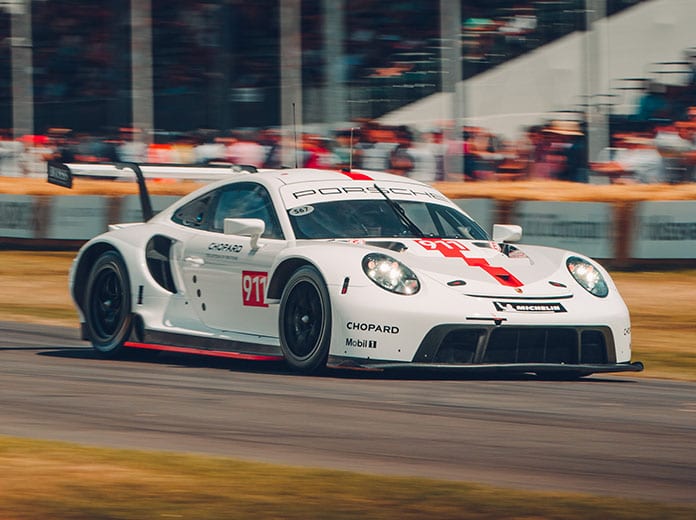GOODWOOD, England – Porsche will put its faith in a new 911 RSR to defend its FIA World Endurance Championship titles and continue the German marque’s ongoing success in the GT Le Mans class of the IMSA WeatherTech SportsCar Championship here in North America.
The race car, which complies with all FIA LMGTE regulations, is a completely new development over the present generation car which has raced since 2017.
The machine has undergone improvements in all areas and will replace the successful 911 RSR, with which Porsche won the manufacturers’ and drivers’ world championship in the FIA WEC, the 24 Hours of Le Mans and eight IMSA races, including major endurance events at Sebring and Road Atlanta during its platform life.
“Since 2017, the 911 RSR has yielded us more than 20 class wins in the world championship as well as at long-distance series in North America and Europe,” said Fritz Enzinger, Vice President Porsche Motorsport. “Our job in the development was to make a very good car even better. The engineers at Weissach have perfectly implemented this in every aspect.”
The Porsche GT Team will field two works cars in eight rounds of the 2019/2020 calendar with 2018/2019 FIA World Champions Michael Christensen and Kévin Estre (France) as well as Gianmaria Bruni and Richard Lietz.
“We never rest on our laurels. We’ve extensively analyzed all factory and customer campaigns with the Porsche 911 RSR. Our engineers noticed room for improvement in a number of areas,” said Pascal Zurlinden, Director GT Factory Motorsport. “We have made significant progress in the development of our car for the next three-year homologation period, especially in the complex areas of drivability, efficiency, durability and serviceability. Ninety-five percent of the car is new. The only components that we’ve kept unchanged from the predecessor are the headlights, brake system, clutch, driver’s seat and parts of the suspension. Tests so far have run excellently. We’re already looking forward to the first races of the 2019/2020 FIA WEC season.”
In the IMSA WeatherTech SportsCar Championship, the switch to the latest model will take place for the 2020 season as the two-car program fights for the GT Le Mans title. The first public laps of the car in North America will be at the 2020 IMSA Roar Before the Rolex 24 at Daytona Int’l Speedway in early January. The first competition laps will come later in the month at the Rolex 24. For customer teams, the vehicle will be available for purchasing beginning with the 2020/2021 FIA WEC season.
“First of all, I’m really pleased that nothing serious happened to the driver in the terrible accident involving the prototype car,” said Steffen Höllwarth, Program Manager, IMSA WeatherTech SportsCar Championship. “That’s the most important thing. As far as our race result is concerned, I’m simply proud of everyone. We very deliberately implemented two different strategies to be prepared for all eventualities. In terms of the team and the drivers, the race was perfectly executed. Five wins in a row is the well-deserved reward for the great work over these intense weeks.”
In terms of the drivetrain, Porsche remains faithful to its chosen path. The latest 911 is powered by a six-cylinder naturally aspirated engine. The highly efficient boxer unit positioned in front of the rear axle has a capacity of 4.2-liters (256 cubic in / 4,194 cc) and – depending on the size of the air restrictor mandated by each sanctioning body – produces approximately 515 horsepower.
The new power unit is the largest boxer engine to be mounted in a Porsche 911 to-date, and offers stronger drivability over a wider rev-band compared to the predecessor’s proven four-liter unit. Power is delivered to the rear wheels via a weight-optimized, sequential six-speed constant-mesh gearbox which has been made more rigid for the new model.
The new powertrain in the Porsche 911 RSR ensures faster gear-shift times and increased efficiency. Two exhaust pipes now exit on each side of the iconic 911-shape in front of the rear wheels. The new exhaust gas ducting saves weight and is aerodynamically advantageous over previous generation 911 race cars which had exhaust pipes that exited at the rear of the car.
With the repositioning of the tailpipes, space has been made for an aerodynamically optimized rear diffuser. The distinctive component at the rear of the Porsche 911 RSR now generates more downforce from the airflow under the car. Thanks to the optimization of airflow at the front and the sides, aerodynamic efficiency and stability have increased significantly, thereby further improving the use and durability of the Michelin tires during racing.
Drivability and serviceability are critical factors in long-distance racing. For this reason, Porsche placed particular emphasis on these aspects when developing the new 911 RSR. The cockpit has been reworked with the focus on better usability for drivers and technicians alike. In this regard, extensive feedback from the Porsche drivers proved invaluable. Like with its predecessor, the body made of carbon-fiber reinforced plastic can be swapped out quickly and thus ensures efficient pit processes in long-distance racing.
To give drivers further added protection, the active and passive safety elements in the Porsche 911 RSR have been further updated. The proven collision warning system introduced on the previous generation 911 RSR, allows drivers a better overview to detect approaching prototype vehicles earlier to minimize incidents during overtaking. The optimized roll cage, the FIA side impact panel in the door and cage as well as additional impact protection for the legs improve the passive safety in the event of an accident. Other features include the removable roof hatch and the rigidly-mounted racing seat featuring a six-point safety harness for the driver.
